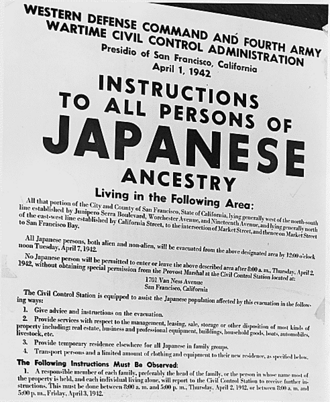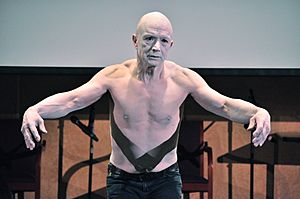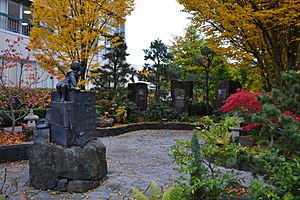Day of Remembrance (Japanese Americans) facts for kids
Quick facts for kids Day of Remembrance (Japanese Americans) |
|
|---|---|

(April 1 orders, based on legislation signed on February 19, 1942)
|
|
| Official name | Day of Remembrance |
| Observed by | Primarily states within the United States |
| Type | National |
| Significance | Commemoration of Japanese Americans who were affected by internment during World War II |
| Observances | Gathering, commence, discussion, activism, art/history exhibits, brief history |
| Date | February 11 |
| Frequency | Annual |
| Related to | Incarceration of Japanese Americans, World War II, Executive Order 9066, Franklin D. Roosevelt |
The Day of Remembrance is a day to remember a difficult time in American history. During World War II, about 120,000 Japanese Americans were forced to leave their homes. They were sent to live in special camps, which is known as internment. This happened because of a government order.
On February 19, 1942, President Franklin D. Roosevelt signed Executive Order 9066. This order allowed the military to remove people of Japanese ancestry from the West Coast. The Day of Remembrance is held on or near February 19 each year to make sure this injustice is never forgotten.
Events take place across the United States, especially in states where Japanese Americans were sent to camps. These states include California, Washington, Oregon, Arizona, and Colorado. The day is a time for people to learn, talk, and reflect on what happened.
Contents
How the Day of Remembrance is Observed
The Day of Remembrance is observed in many ways across the country. Events often include speeches, discussions, and presentations about the history of the internment. People share stories, watch films, and look at art created by those who were in the camps.
These events are meant to educate the public. They remind everyone about the importance of protecting the rights of all citizens. It is a day for remembering the past and speaking out against injustice.
Washington
The very first Day of Remembrance was held in Washington state on November 25, 1978. It was organized by a group called the Evacuation Redress Committee. The event took place at the Puyallup fairgrounds, which was used as a temporary camp called Camp Harmony in 1942.
To recreate the journey people were forced to take, a caravan of large trucks drove from Seattle to Puyallup. This showed what it was like for the internees. One of the main organizers was writer Frank Chin.
Since 2003, Washington has officially recognized the Day of Remembrance. In 2008, the University of Washington gave honorary degrees to 449 former Japanese American students. Their education was interrupted when they were forced to leave for the camps.
Oregon
Oregon held its first Day of Remembrance on February 17, 1979. The event was held at the former site of the Portland Assembly Center. This was another place where Japanese Americans were held before being sent to permanent camps.
Today, the Japanese American Museum of Oregon has exhibits about this history. The Japanese American Citizens League (JACL) in Portland also holds events. These events help teach the public and encourage people to stand up for the rights of Asian Americans.
California
In 1986, California's governor officially declared February 19 as a Day of Remembrance. This was more than two years before the U.S. government passed the Civil Liberties Act of 1988. This act formally apologized and provided payment to the surviving internees.
Events are held in places like San Francisco's Japantown. In Los Angeles, the Japanese American National Museum hosts events with speakers, music, and art. These gatherings focus on how people can work together to make democracy stronger.
Colorado
In Colorado, a Day of Remembrance event was held at the History Colorado Center in Denver in 2013. Five Japanese Americans who were children during the internment shared their powerful stories. They spoke about being forced from their homes and what life was like afterward.
Colorado was also home to the Amache camp. In March 2022, this site officially became the Amache National Historic Site, part of the National Park system. It serves as a place for people to learn and remember what happened there.
Other States
- Arizona: Events in Arizona have included discussions with families affected by the internment. The University of Arizona has also hosted panels looking at how Japanese Americans fought against the injustice of Executive Order 9066.
- Alaska: In 2016, an event was held at Joint Base Elmendorf–Richardson. A speaker named Alice Tanaka Hikido shared her story of being sent to a camp when she was just 9 years old. The event was held on the site of a lesser-known internment camp.
- Utah: Salt Lake City's Japantown has held Day of Remembrance events. In 2005, an event at the Japanese Church of Christ included speakers and a film. The film was about Tōyō Miyatake, who secretly took photos inside the Manzanar camp.
- Idaho: Idaho has been observing the Day of Remembrance since the early 2000s. Events often include film screenings that discuss civil rights. In 2024, a film by artist Kishi Bashi called Omoiyari was shown. It explored how the legacy of the internment affected him and many others.
Art and Photo Exhibits
Art is a powerful way to remember history. Many museums and universities have created special exhibits for the Day of Remembrance.
In Utah, an exhibit at the University of Utah featured photos by Dorothea Lange and Ansel Adams. Their pictures showed the experiences of people who were forced into the camps.
In Juneau, Alaska, the Juneau-Douglas City Museum displayed an exhibit about the Japanese community that was removed from the city. It features a sculpture called The Empty Chair. The sculpture is a bronze chair that honors a Japanese American student who was unable to graduate with his high school class because he was in a camp.
See also
- Bainbridge Island Japanese American Exclusion Memorial
- Densho: The Japanese American Legacy Project
- Empty Chair Memorial
- Fred Korematsu Day
- Go for Broke Monument
- Harada House
- Japanese American Memorial to Patriotism During World War II
- National Japanese American Veterans Memorial Court
- Sakura Square
- Japanese American redress and court cases
- Japanese American service in World War II





